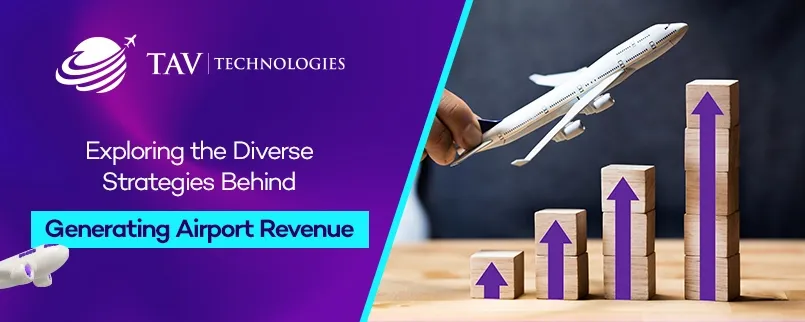
Mar 2024
In the dynamic landscape of airport management, the partnership between airports and technology companies is pivotal, serving as a cornerstone for achieving financial stability and an enriched traveler experience. This blog post explores a spectrum of both traditional and modern strategies, aiming to strengthen revenue streams. A significant aspect of the innovative approaches discussed in this blog post underscores the need for a robust digital strategy.
1-Retail and Concessions
Existing Methods: Airports traditionally rely on duty-free shops, restaurants, and cafes to boost revenue. Offering a diverse range of retail and dining options attracts more foot traffic, translating into increased sales.
New Approaches: Digital Marketplace Integration: Collaborate with technology solutions to seamlessly integrate a digital marketplace within the airport app.
Travelers can pre-order and pick up items, enhancing the convenience of duty-free shopping. As exemplified by TAV Technologies' Pre-Order Management Platform, mobile-based solutions empower passengers to engage seamlessly in online ordering and shopping experiences. This innovative platform enables travelers to select their desired items before reaching the airport, streamlining the process for retailers and passengers alike. It introduces a convenient and efficient way for individuals to plan their purchases and enhances the overall shopping experience within the airport environment.
Curated Local Partnerships: Look for alliances with local artisans and businesses to bring unique, locally crafted products to airport retail spaces, providing travelers with an authentic shopping experience.
2-Advertising Opportunities
Existing Methods: Advertising within the terminal, on the airport's website, and through digital displays remains a significant revenue source. Partnerships with local and national brands create valuable advertising opportunities for a diverse audience.
New Approaches:
-Interactive Digital Displays: Implement interactive displays for engaging content, seamlessly blending advertisements into the airport experience.
-Data-Driven Targeting: Leverage passenger data for precise targeting, ensuring that advertisements resonate effectively with diverse demographics passing through the airport.
Passenger flow technologies developed by leading airport technology providers enables a comprehensive understanding of high-traffic zones within airports. This insight empowers airport operators to optimize these areas for strategic advertising placements. TAV Technologies offers a cutting-edge Passenger Flow Management Platform, presenting a tailored solution for efficient airport operations and enhanced passenger experiences.
3-Parking and Transportation Fees
Existing Methods:Charging fees for parking, rental car services, and shuttle buses remain a steadfast revenue stream. Implementing user-friendly payment systems ensures convenience for travelers.
New Approaches:
-Contactless Payment Systems: Introduce contactless payment systems for parking and transportation services, aligning with evolving traveler preferences.
-Eco-Friendly Transportation Options: Incorporate eco-friendly transportation services, such as electric shuttles, with premium pricing to attract environmentally conscious travelers.
4-Terminal Rentals
Existing Methods: Renting out terminal spaces, including gates, ticketing counters, and baggage claim areas, provides a consistent income stream for airports.
New Approaches:
-Flexible Shared Spaces: Develop on-demand, flexible shared spaces within terminals, allowing for pop-up stores, exhibitions, and events, creating a dynamic airport environment.
-Virtual Reality Lounges: Introduce virtual reality lounges available for rent by airlines, providing unique in-flight experiences to passengers awaiting their flights.
5-Property Development
Existing Methods: Generating income through property development involves constructing hotels, office buildings, and commercial real estate on airport property.
New Approaches:
-Smart Infrastructure: Integrate smart infrastructure into new developments, featuring energy-efficient buildings and automated systems to attract environmentally conscious tenants.
-Mixed-Use Developments: Explore mixed-use developments that combine residential, commercial, and recreational spaces, transforming airports into vibrant city centers.
In addition to the revenue streams mentioned above, airports generate revenue through airplane and airline-related activities.
6-Landing Fees:
Many airports charge airlines landing fees for the use of their facilities. These fees are typically based on the size and type of aircraft, as well as the length of the landing.
7-Terminal Usage Fees:
Airports may also charge airline terminal usage fees for using terminal space, gates, and other facilities. These fees can be based on various factors, such as the number of passengers, the flight duration, and the aircraft size.
8-Airline Rentals:
Some airports also generate revenue by renting airline office space or other facilities. This can include space for airline staff and operations and storage and maintenance facilities for aircraft.
9-Aircraft Maintenance and Repair:
Airports may also generate revenue through aircraft maintenance and repair services. This can include everything from routine maintenance to major repairs and may be provided to commercial and private aircraft.
Commercial Management System: The Central Solution for Revenue Management
By strategically combining established revenue generation methods with innovative approaches, airports can secure financial stability and create a dynamic and engaging environment for travelers. TAV Technologies' commercial management system(CMS) is a direct solution to controlling all kinds of airport revenue streams. CMS ensures precise calculation of both aeronautical and non-aeronautical service usage. By seamlessly integrating operational and invoice data, the system provides accuracy. Its flexible tariff management and data consistency features empower airport management to generate error-free invoices effortlessly.
In conclusion, the partnership between airports and technology companies drives innovative revenue streams, ensuring financial stability and enhancing traveler experiences. From digital marketplace integration to data-driven advertising and eco-friendly transportation options, airports are modernizing to meet evolving demands. By embracing innovation and strategic partnerships, airports can secure long-term success while meeting the changing needs of travelersTop of Form
